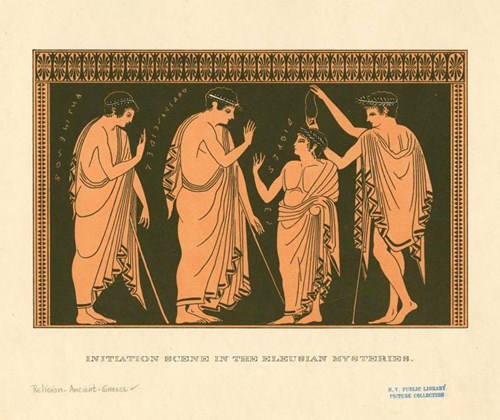Epopteia
The epopteia was the highest degree of initiation into the Greater Mysteries. The mystai became eligible one year after the initiation ceremony, but the epopteia was not deemed an essential prerequisite for being considered initiated into the Mysteries. Instead, it was designed for those who wanted to gain a greater and more complete understanding of the content of the cult of Demeter. The celebration of the epopteia was probably held at the Telesterion on the second night in Eleusis (21st of Boedromion). However, some theories distribute the events associated with the epopteia on both nights of the ceremonies in the temple.

Initiation scene in the Eleusinian mysteries, 1893, engraving, The New York Public Library © The New York Public Library
There is no specific information on the content of the epopteia or the duration of its rituals. Absolute secrecy covers epopteia. The word signifies revelation and contemplation, so it is speculated that the ceremony included the display of sacred objects. Some Christian writers (e.g. Hippolytus, who lived in Rome at the beginning of the third century) claimed that the great mystery revealed by the priests to the faithful was a reaped ear of corn. Still, the presence of ears of corn in art (the Lacrateides relief, the entablature of the Lesser Propylaea, the Caryatids) seems to argue against such a proposition, as it would be inconceivable to display in the eyes of the uninitiated the supreme (supposedly) sacred object with which the initiation culminated.
Tertullian from Carthage (160-220 AD) claimed that the sacred symbol of the epopteia was the phallus. This would imply a role for the god Dionysus during the second night at the Telesterion. However, the theory goes against the absence of Dionysus from the list of Eleusinian deities to which sacrifices are due and from the myth of Demeter and Persephone preserved in the Homeric Hymn (which is considered to reflect the Eleusinian form of worship). Until the discovery of new facts, the content of the higher stage of initiation into the Greater Mysteries will remain unknown and controversial.





